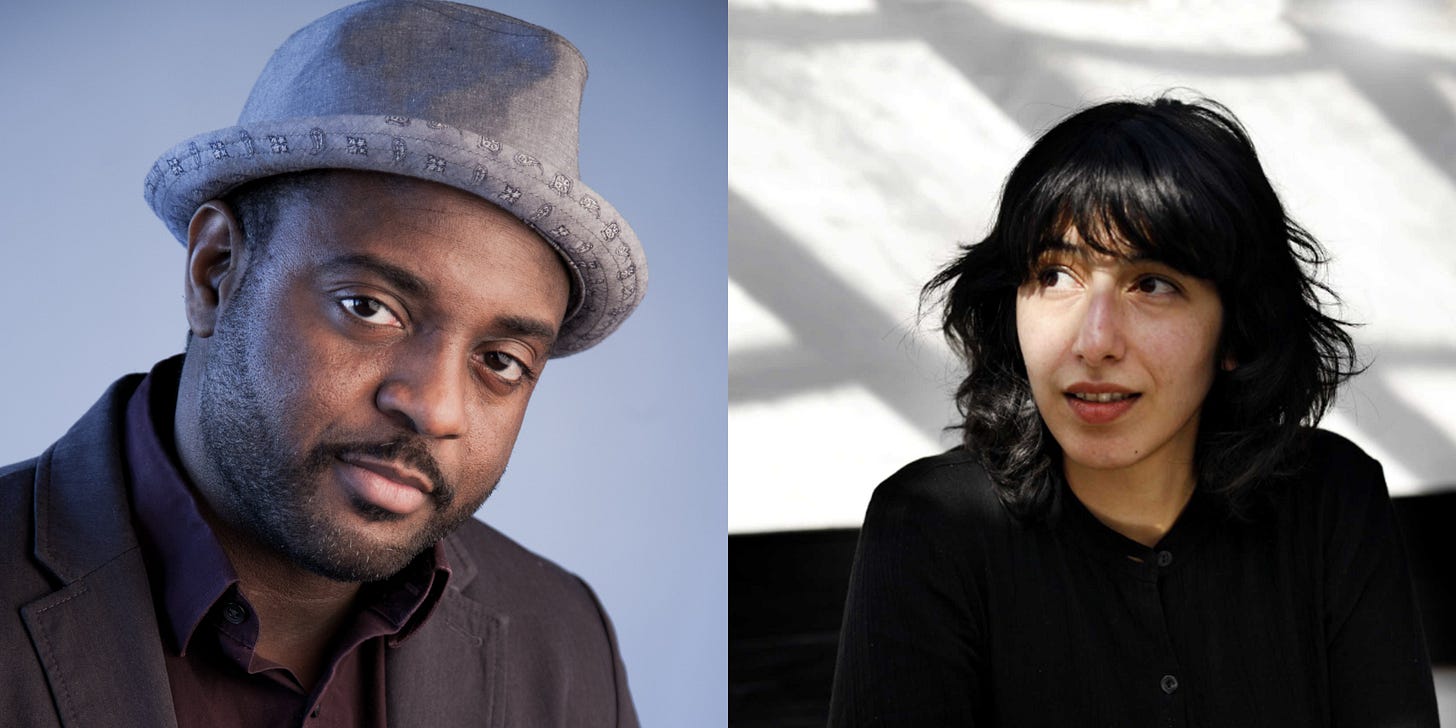Many use the new year as an injection of resolve to shed old habits, to leave things or even people behind. A new year, a continued refinement of objects or activities as a path to reveal what we hope to be our truer selves. The reality is that each year expands our experience, enlarging the block from which we continually chisel ourselves.
Poets know this process well. Mastering concision to tell a story. In redaction poems the reader has the opportunity to observe the distillation in progress, looking on as the poet strikes lightly or marks heavy until what remains cannot be denied.
For two poets the act of redaction brings injustice to light.
Reaching Guantánamo is a collection of nine imagined letters from a wife to her detained husband written by Iranian-American poet Solmaz Sharif. Each letter is constructed with light redactions made to madden the detainee with missing details. What reads as an interrupted dialogue also reveals an intimacy undeterred by distance and time.
Read letters (1) (2) (3) (4) (5) (6) (7) (8) and (9) from Reaching Guantánamo published in the Summer 2010 issue of paperbagazine. Relish in that 2010 internet user interface.

In Reginald Dwayne Betts’ 2019 Felon, he sets stirring poems within court documents of four states. He reverses the tradition of using redaction to hide what’s sensitive, instead removing everything that serves to buffer the voice of the original writer. What remains is the high cost of being poor.
Read all of “In Missouri” included in his interview on Plume Poetry. Learn more about Betts’ work with Freedom Reads which brings literature to prisons and the Civil Rights Corps which focuses on bail reform.
These collections are in a sense literary action paintings: abstract, gestural and visceral at once. Carving enormous context down to a clarified statement.
If there is ever an opportunity for a cook to tread this same path, it’s when making stock.
Start with the body of an animal. Use it fully. Expand its context with aromatics. Present it back in a new form, both pressed for simplicity and doubly complex. Distilled to its purest gesture.
Harsa Halászlé - Hungarian Fisherman’s Soup
The majority of Americans are still hesitant of carp at the dinner table, making the traditional fish for this soup challenging to find stateside. Luckily, fish mongers and Asian supermarkets still generally carry whole versions of its freshwater cousin, the catfish, that will allow you to make the stock that carries the heart of this soup.
Note: Most places that sell whole fish will clean and filet it for you, just make sure to ask to keep the ‘remains’ up front before they get tossed.
what you need
stock: 1 1/2 pounds catfish bones, heads or tails ◾ 2 medium yellow onions, quartered ◾ 1 beefsteak tomato, quartered ◾ 1 green bell pepper, quartered ◾ 2 Hungarian wax (more hot) or Anaheim (less hot) peppers ◾ 1 tablespoon kosher salt ◾ 6 cups water
soup: 3 tablespoons paprika ◾ 1/2 cup dry red wine ◾ 1/2 teaspoon cayenne pepper ◾ 1 1/3 pound catfish, cut into 4 fillets
what to do
To make stock, add all ingredients to a large stock pot and bring to a boil. Reduce to a simmer and cook for one hour. Using a fine mesh strainer or cheese cloth and a large bowl, strain vegetables and fish, pressing to get all the juices out. Return stock to pot.
To the stock, add the paprika, cayenne pepper and wine. Bring to a simmer, reducing for roughly 10 minutes.
Add the fish fillets to the stock. Cover to poach, roughly 5-8 minutes depending on size.
Serve with a dry white like Furmint and a hearty bread.
Welcome to The Dinner Conjurer, the newest addition to our regularly scheduled programming. You’ll send in the name or a short description of 5 recipes you’ve enjoyed, your name and current hometown. I’ll help idea-exhausted cooks lure new recipes into their dinner routine.
A big thank you to John Warner of The Chicago Tribune and The Biblioracle Recommends newsletter for graciously encouraging me to adapt his book recommendation model for recipes.
Michelle Z. from Seattle, WA has been cooking:
Shredded chicken and black bean tacos
Spaghetti and meatballs with roasted broccoli
Spanakopita and lemon chicken
Tofu tikka masala, Indian creamed spinach, and rice
Michelle, it looks like you’ve got an eye for international recipes that are long on greens and short on hard to find ingredients. Try baking or grilling chicken that’s been marinated in Hawa Hassan’s piri-piri sauce with a side of coconut-braised collard greens reminiscent of her unbeatable mbowa recipe from In Bibi’s Kitchen.
If spicy isn’t your style, get your hands on some pomegranate molasses to make Louisa Shafia’s sweet and sour chicken fesenjan, an Iranian pomegranate-walnut stew, from The New Persian Kitchen. Serve it over jasmine rice.
Reading - Harlem Shuffle by Colson Whitehead (2021) ahead of another attempted IRL book club lost.
Listening - to the forbidden taste of tarhana, an Armenian fermented porridge.
Watching - Don’t Look Up by Adam McKay (2021) which is proving to be last year’s movie too packed with stars to be anything more than that.
Smelling - Lust by LUSH (2010) right in time for a revival of early ‘10s Tumblr indie aesthetics.









Any suggestions for a vegan/vegetarian homemade stock? We usually use Swanson Vegetable Broth, which is pretty good and adds a nice gentle flavor to anything.
I love the new “dinner conjurer” section!